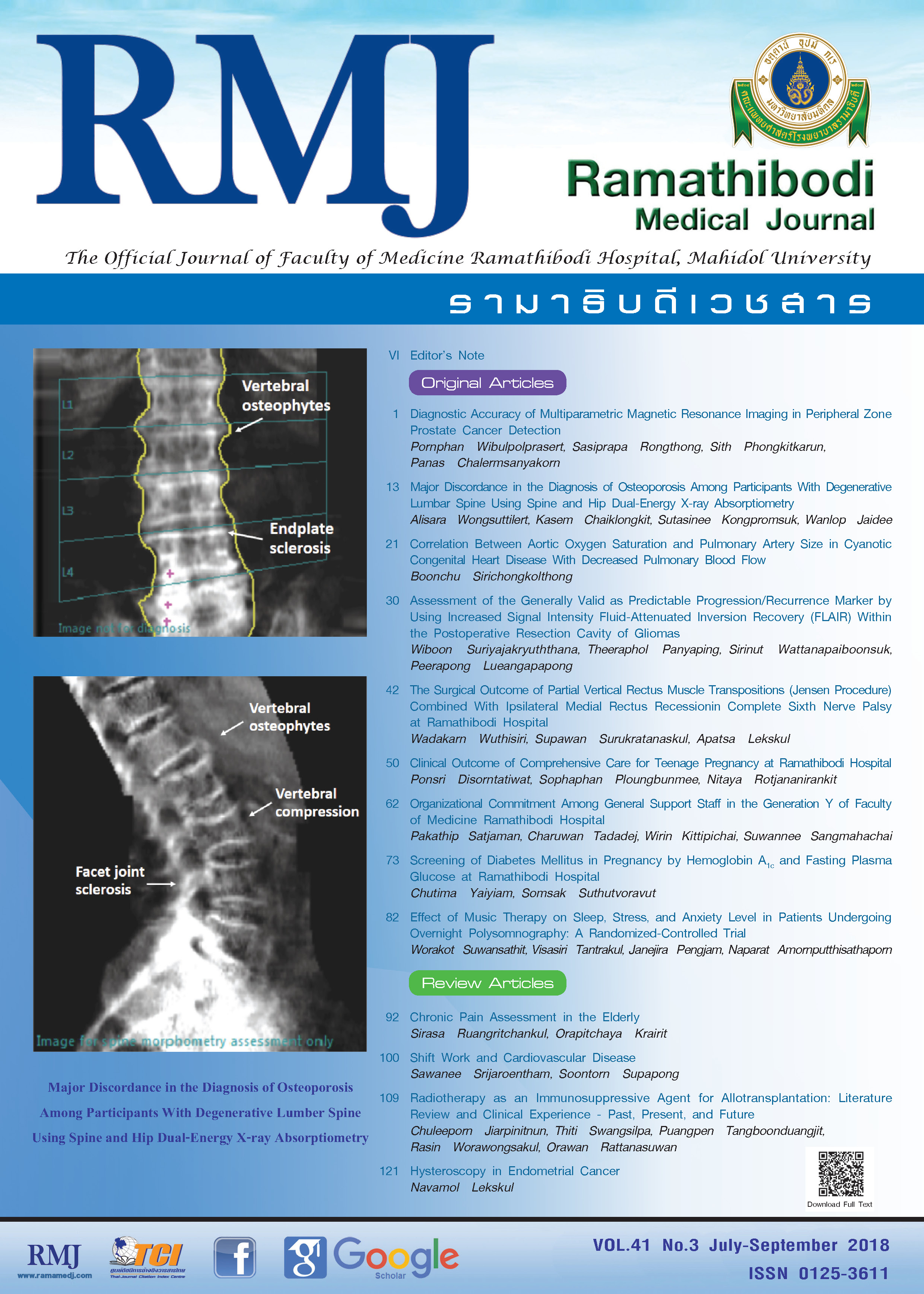Assessment of the Generally Valid as Predictable Progression/Recurrence Marker by Using Increased Signal Intensity Fluid-Attenuated Inversion Recovery (FLAIR) Within the Postoperative Resection Cavity of Gliomas
DOI:
https://doi.org/10.14456/rmj.2018.28Keywords:
Fluid-attenuation inversion recovery, Signal intensity, Brain tumorAbstract
Background: Monitoring progression/recurrence brain glioma after surgery is the most important for therapeutic planning.
Objective: To verify that an increased signal intensity (SI) in resection cavity of brain glioma by fluid-attenuated inversion recovery (FLAIR) can be predictor of tumor progression/recurrence.
Methods: A retrospective cross-sectional study in patients who underwent surgery at Ramathibodi Hospital with pathological proven brain gliomas (grade II, III, and IV) from January 1, 2010, to July 31, 2016, was performed. Postoperative magnetic resonance imaging (MRI) after 3 months was analyzed and measured for SI in surgical cavity, compared with SI of cerebrospinal fluid (CSF) in the contralateral frontal horn.
Results: Sixteen men and sixteen women with mean age 41.25 years were included. Thirty-one cases had partial resection and one case complete resection. The pathological diagnosis were 20 cases of high-grade gliomas and 12 cases of low-grade gliomas. Chemotherapy and radiotherapy were given in 16 cases. An increased SI in the surgical cavity by FLAIR had sensitivity of 77.3% and specificity of 50%.
Conclusions: Fair specificity and sensitivity of increased FLAIR SI for detection of tumor progression/recurrence was found. However, FLAIR is usually performed in standard MRI with no additional time or radiation hazard.
References
Ostrom QT, Bauchet L, Davis FG, et al. The epidemiology of glioma in adults: a “state of the science” review. Neuro Oncol. 2014;16(7):896-913. doi:10.1093/neuonc/nou087.
Veerasarn K, Yuthagovit S. Prevalence of brain tumor in Thailand from 2005 to 2014: data from the National Health Security Office. J Med Assoc Thai. 2016;99(Suppl 3):S62-S73.
Louis DN, Ohgaki H, Wiestler OD, et al. The 2007 WHO classification of tumours of the central nervous system. Acta Neuropathol. 200;114(2):97-109. doi:10.1007/s00401-007-0243-4.
Jacobs AH, Kracht LW, Gossmann A, et al. Imaging in neurooncology. NeuroRx. 2005;2(2):333-347. doi:10.1602/neurorx.2.2.333.
Weber MA, Giesel FL, Stieltjes B. MRI for identification of progression in brain tumors: from morphology to function. Expert Rev Neurother. 2008;8(10):1507-1525. doi:10.1586/14737175.8.10.1507.
Winterstein M, Münter MW, Burkholder I, Essig M, Kauczor HU, Weber MA. Partially resected gliomas: diagnostic performance of fluid-attenuated inversion recovery MR imaging for detection of progression. Radiology. 2010;254(3):907-916. doi:10.1148/radiol.09090893.
Ito-Yamashita T, Nakasu Y, Mitsuya K, Mizokami Y, Namba H. Detection of tumor progression by signal intensity increase on fluid-attenuated inversion recovery magnetic resonance images in the resection cavity of high-grade gliomas. Neurol Med Chir (Tokyo). 2013;53(7):496-500. doi:10.2176/nmc.53.496.
Coppola V, Federici M, Calabria LF, et al. Can fluid-attenuated inversion recovery (FLAIR) MR imaging predict the gliomas progression? European society of radiology. 2013. doi:10.1594/ecr2013/C-2033.
Bette S, Gempt J, Huber T, et al. FLAIR signal increase of the fluid within the resection cavity after glioma surgery: generally valid as early recurrence marker? J Neurosurg. 2017;127(2):417-425. doi:10.3171/2016.8.JNS16752.
Wen PY, Macdonald DR, Reardon DA, et al. Updated response assessment criteria for high-grade gliomas: response assessment in neuro-oncology working group. J Clin Oncol. 2010;28(11):1963-1972. doi:10.1200/JCO.2009.26.3541.
Thomas AA, Arevalo-Perez J, Kaley T, et al. Dynamic contrast enhanced T1 MRI perfusion differentiates pseudoprogression from recurrent glioblastoma. J Neurooncol. 2015;125(1):183-190. doi:10.1007/s11060-015-1893-z.
Galldiks N, Dunkl V, Stoffels G, et al. Diagnosis of pseudoprogression in patients with glioblastoma using O-(2-[18F]fluoroethyl)-L-tyrosine PET. Eur J Nucl Med Mol Imaging. 2015;42(5):685-695. doi:10.1007/s00259-014-2959-4.

















